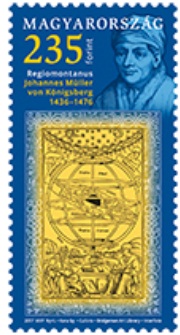
style="display:block"
data-ad-client="ca-pub-6935274628036882"
data-ad-slot="3184055459"
data-ad-format="auto">
1. Magyar - 550 éve érkezett Magyarországra Regimontanus
2. English - Regiomontanus arrived in Hungary 550 years ago
1. Magyar - 550 éve érkezett Magyarországra Regimontanus
A Magyar Posta alkalmi bélyeg kibocsátásával köszönti Regiomontanus Magyarországra jövetelének 550. évfordulóját. A bélyeg Kara György grafikusművész tervei szerint az ANY Biztonsági Nyomdában készült 200.000 példányban. Az újdonság február 3-tól kapható.
Regiomontanus (1436 – 1476; eredeti neve Johannes Müller) matematikus, csillagász, asztrológus.
A kor szokása szerint szülővárosának, a frankhoni Königsbergnek latin nevét vette fel. Évekig élt és dolgozott Budán, és Mátyás király iránti tiszteletből abudai királyi palotán áthaladó délkört vette alapul csillagászati számításaihoz. Ez volt a budai délkör. Csodagyerek volt, 11 éves korától kezdve Lipcsében, majd Bécsbenmatematikát és csillagászatot tanult,
12 éves korában már bolygópályákat számított. Megbízták Ptolemaiosz Almagest c. munkájának kritikai fordításával, amit később Kopernikusz és Galilei tankönyvként használt. Ugyanebben az időben keletkezett a háromszögekről szóló műve. Mátyás király meghívására a pozsonyi egyetemen adott elő, ahol fél évszázaddal Kopernikusz előtt már a Föld mozgását tanította, illetve azt, hogy miként kell az égboltozat látszólagos mozgását időmérésre használni.
1467-ben Magyarországra utazott, ahol Esztergomban, Vitéz János palotájában csillagvizsgálót rendezett be. 1468-71 között Mátyás király udvarában élt, ahol a Corvina könyvtár görög kéziratait rendezte. Itt írta Ephemerides c. csillagászati művét, amelyet felfedező útján Kolumbusz is használt.
1471-ben elhagyta Magyarországot és Nürnbergbe költözött, ahol olyan nyomdát rendezett be, amely alkalmas volt a bonyolult matematikai és csillagászati számítások jó minőségű kinyomtatására. Felállított továbbá egy korszerű csillagvizsgálót is.
1475-ben IV. Sixtus pápa felkérésére közreműködött a naptárreformban. Rómában halt meg, mielőtt a munkát elvégezhette volna. Halálának hivatalos oka a pestis, de a szóbeszéd szerint a trapezunti Georgiosz fiai mérgezték meg, amiért apjuk Almagest-fordítását Regiomontanus élesen bírálta. Igen sok jel mutat arra, hogy csak korai halála akadályozta meg abban, hogy a döntő lépést megtegye, és áttérjen a heliocentrikus rendszerre.
A bélyegképen Regiomontanus portréja és egy munkásságát idéző metszet látható, melyen középen a föld és a csillagjegyek, fent az ég, lent balra Ptolemaiosz, jobbra pedig a neves tudós szerepel. A borítékon Regiomontanus asztrolábiuma található.
Forrás: Posta
style="display:block"
data-ad-client="ca-pub-6935274628036882"
data-ad-slot="3184055459"
data-ad-format="auto">
2. English - Regiomontanus arrived in Hungary 550 years ago
Magyar Posta is commemorating the 550th anniversary of the arrival of Regiomontanus in Hungary by issuing a special stamp. 200 000 copies of the stamp designed by the graphic artist György Kara were produced by ANY Security Printing Company.
Regiomontanus (1436-1476; original name: Johannes Müller) was a mathematician, astronomer and astrologer. As was the custom at the time, he adopted the Latin name of his town of birth, Königsberg in present-day Germany. He worked and lived in Buda for years, and as a sign of respect for King Matthias,he took the meridian passing through the royal palace in Buda as the basis for his calculations in astronomy. This was the meridian of Buda. Regiomontanus was a child prodigy, and started studying mathematics and astronomy at the age of 11, first in Leipzig and then in Vienna. When he was 12, he calculated the orbits of planets. He was entrusted with the critical translation of Ptolemy’s Almagest, which was later used as a textbook by Copernicus and Galileo. His work on triangles originates from the same period. At the invitation of King Matthias, he lectured at the University of Pozsony (Bratislava), where – half a century before Copernicus – he taught about the motion of the Earth and how the perceived movement of the sky can be used to measure time.In 1467, he travelled to Hungary, where he set up an observatory in the palace of John Vitéz, the archbishop of Esztergom. Between 1468 and 1471, he lived in the court of King Matthias, arranging the Greek manuscripts of the Corvina Library.
style="display:block"
data-ad-client="ca-pub-6935274628036882"
data-ad-slot="3184055459"
data-ad-format="auto">
This is where he wrote his book on astronomy Ephemerides, which was used by Christopher Columbus on his voyage of discovery.In 1471, Regiomontanus left Hungary and moved to Nuremberg. There, he founded a press where complicated mathematical and astronomical calculations could be printed in good quality. He also set up a modern observatory. In 1475, at the request of Pope Sixtus IV, he participated in the work on the reform of the calendar. He died in Rome before being able to complete his work. The official reason for his demise was the black death, but rumour has it that the sons of George of Trebizond murdered him for his harsh criticism of their father’s Almagest translation. There are many signs that only his early death stopped him from taking the decisive step and adopting heliocentrism.
The stamp shows a portrait of Regiomontanus together with a cross-section recalling his work, depicting the Earth and the astrological signs in the middle, the sky on the top, Ptolemy at the bottom left and the renowned scientist at the bottom right. An astrolabe built by Regiomontanus is shown on the first day cover.
Source: Hungary Post


